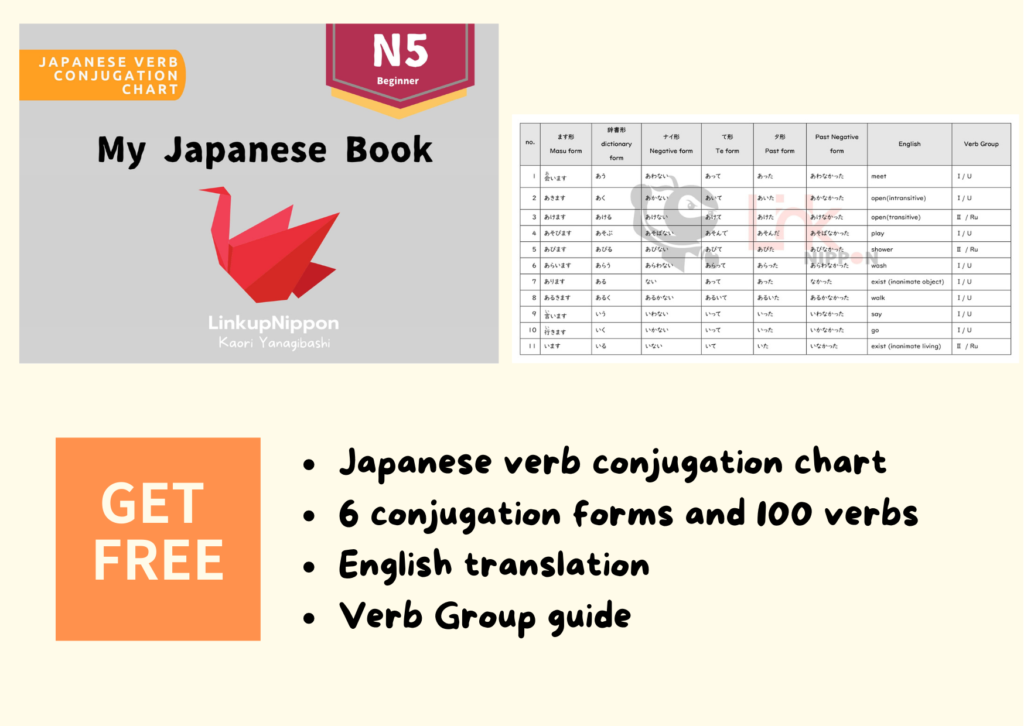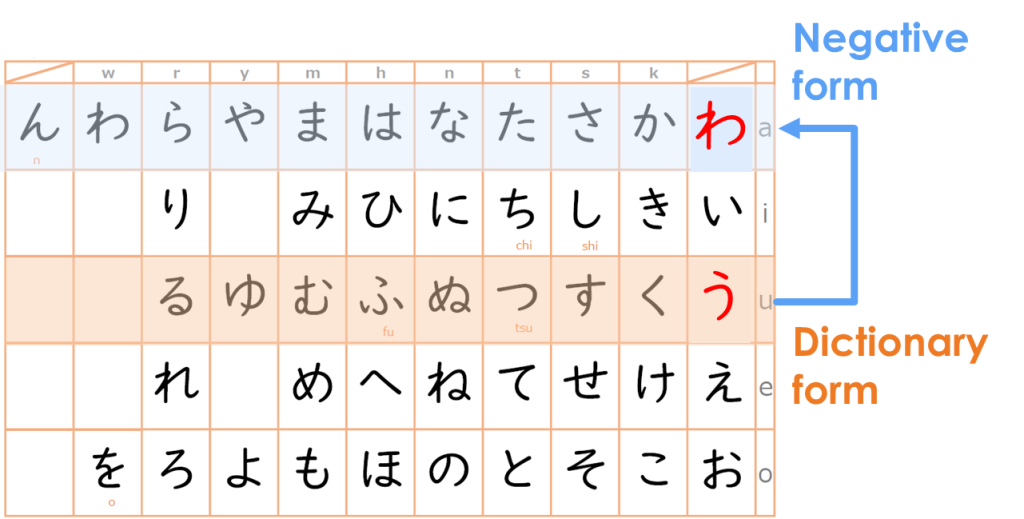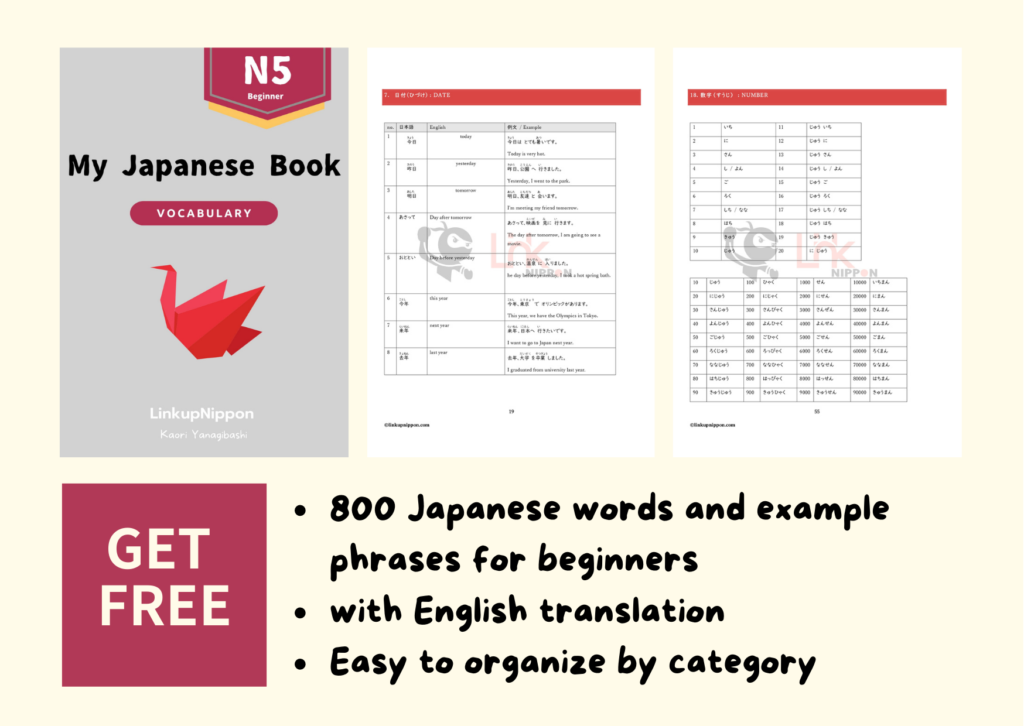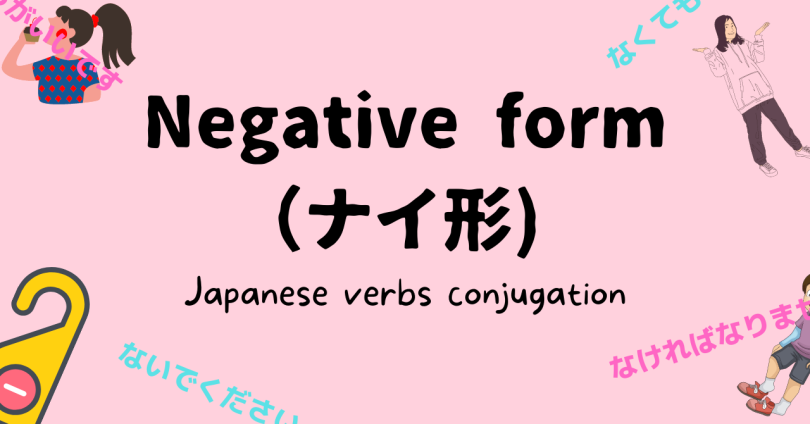As the name suggests, negative form is used to negative an action. The negative of Masu form is “たべます” → “たべません”. So what is the negative form of Dictionary form ”たべる”?
Today I will show you how to make negative forms and introduce some important expressions used at the beginner level.

Table of contents
How to make Negative form?
The steps of conjugation are always two steps.Anyway Japanese verb conjugations are first grouped, then the rules for each group are applied
Step1. Divide verbs into groups
We can divide Japanese verbs into 3 groups. If you are not yet confident in your grouping, check out this article first to see how to group them.
| U verbs / GroupⅠ | Ru verbs / Group Ⅱ | Irregular verb / Group Ⅲ |
|---|---|---|
| のむ : drink | たべる : eat | する : do |
| あう : meet | おきる : get up | くる : come |
| きく : listen | ねる : sleep | |
| およぐ : swim | みる : watch |
Step2. Convert to Negative form
Today I will explain how to convert from Dictionary form to Negative form. Let’s look at Group II (Ru verbs), III (Irregular verbs), and finally Group I (U verbs).
GroupⅡ / Ru-verbs
たべ
“る” remove, add “ない”.る→ たべ ない
Group II is always easy! Say goodbye to ”Ru”and add ”Nai”.
GroupⅢ / Irregular-verbs
する → しない
Sorry,memorize.
くる → こない
Sorry,memorize.
Note that the kanji characters are the same as “来る” and “来ない”, but the readings are different.
Group Ⅰ / U-verbs
The problem is Group I. But it’s ok. Everyone, please think of the hiragana chart.
かく → かかない
“く” changes to “か”. And add “ない”
There is one exception here. It is “う” Move to “わ” instead of “あ”.
あう → あわない
“う” changes to “わ”. And add “ない”

In Group I, there is always “u-line” when it is Dictionary form. When making Negative form, it changes to “a-line”.
How to practice Negative form?
Step1. Proper understanding of rules
Surely, it seems obvious, doesn’t it? However, when different conjugations are introduced such as Te-form, Ta-form in the future, different rules will be used and many new verbs will be introduced. Therefore, it is important to firmly input “This is the rule for Negative form”.
Step2. Repeat until reflexive
In the beginning, You will think…”Which group is this verb?” ,and then if it is Group I, You will remind that “What is the letter before Masu…..?”.It is the right process. However, when it comes to real conversation, there is no time to think about it. You need to respond reflexively, i.e., within 1-2 seconds.
Definitely,if you want to be able to speak, this time lag can be a problem.So, for this kind of conjugate memorization, use flashcards.The recommended app is Anki. If you haven’t used it yet, please also read this article.
Negative form expressions for beginners
Especially, Negative form is used in a variety of expressions learned in beginner’s grammar. Today we will introduce 4 important ones.
1.~ないでください (Please don’t ~)
:to ask someone to refrain from something or prohibit them from doing something
ここに 車を とめないでください。
Please don’t park a car here.
*とめる → とめない (Group Ⅱ, RU-verbs)
2. なければなりません (must)
:Talk about obligations and what might be considered necessary.
ここで くつ を ぬが なければなりません。
We must take off our shoes here.
*ぬぐ → ぬがない ( Group I , U-verbs)
3. なくてもいいです(don’t have to)
:Something needn’t be done.
子供はお金を払わなくてもいいです。
Children do not have to pay.
*はらう → はらわない ( Group Ⅰ , U-verbs)
4. ないほうがいいです (should not)
: Propose or recommened not to do.
たばこ を すわないほうがいいですよ。
You shouldn’t smoke cigarettes.
*すう → すわない ( Group Ⅰ, U-verbs)
More about Japanese verbs conjugation
Additionlaly,if you want to master Japanese verbs, this is the book for you. Verbs are very important in any language. Let’s master them and learn to speak them!

Please check other verb conjugation, Dictionary form and Ta form. These are also verb conjugations to be mastered at the beginner level! Check them out.
| Japanese verb conjugation table for beginners |
|---|
| マス形 (Masu form)▶ |
| テ形 (Te form)▶ |
| 辞書形 (Dictionary form)▶ |
| ナイ形(Negative form)▶ |
| タ形 (Ta form)▶ |
Did you get the vocabulary list for beginners?








